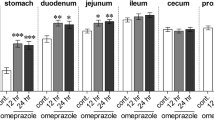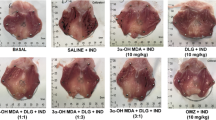Abstract
In the present report we studied the formation of severe gastric erosions produced in fasted rats by intragastric administration of piroxicam (PRX), an enolic acid-derived NSAID. The time course of gastric damage and the possible role of mucus secretion, endogenous sulphydryl compounds, changes of gastric vascular permeability and neutrophil infiltration in the development of PRX-induced gastric lesions were also investigated. PRX dose-dependently (1.25–20 mg/kg) caused acute gastric haemorrhagic erosion in the rat. The lesions increased with time until 9 hr after dosing. Mucus secretion did not change significantly with respect to the control group with 5, 10 and 20 mg/kg of PRX at different times (3 and 6 hours) of treatment. There was also no increase in the concentration of its components. In addition, oral pretreatment of the animals with PRX did not significantly change the amount of dye trapped in the stomach. In contrast, non-protein SH fraction was decreased after administration of PRX and MPO activity as an index of neutrophil infiltration was significantly increased. These results suggest that independently of the PRX dose, depletion of endogenous non-protein SH and neutrophil infiltration could play an important part in the pathogenesis of gastric mucosal injury induced by PRX.
Similar content being viewed by others
References
Graham DY, Agrawal NM, Roth SH. Prevention of NSAID-induced gastric ulcer with misoprostol. Multicentre, doubleblind, placebo-controlled trial. Lancet 1988;2:1277–80.
Konturek SJ. Mechanism of gastroprotection. Scand J Gastroenterol 1990;25 Suppl. 174:15–7.
Mecarthy DM. Nonsteroidal anti-inflammatory drugs — the clinical dilemmas. Scand J Gastroenterol 1992;27 Suppl 174:9–12.
Wallace J. Non-steroidal antiinflammatory drug gastropathy and cytoprotection: pathogenesis and mechanisms re-examined. Scand J Gastroenterol 1992;22:3–8.
Konturek SJ, Brzozowski T, Stachura J, Dembinski A, Malka J. Role of gastric blood flow, neutrophil infiltration in gastric adaptation to aspirin in the rat. Gut 1994;35:1189–96.
Guth P. Current concepts in gastric microcirculatory pathophysiology. Yale J Biol Med 1992;65:677–88.
Jacobson ED. Circulatory mechanisms of gastric mucosal damage and protection. Gastroenterology 1994;102:1788–800.
Allen A, Flemström G, Garner A, Kivilaakso F. Gastroduodenal mucosal protection. Physiol Rev 1993;73:823–27.
Shoen RT, Vender RJ. Mechanisms of nonsteroidal-anti-inflammatory drugs-induced gastric damage. Am J Med 1989;86:449–57.
Szabo S, Pihan G, Dupuy D. The biochemical pharmacology of sulphydryls compounds in gastric mucosal injury and protection. In: Szabo, S, Mózik G, editors. New Pharmacology of Ulcer Disease. New York: Elsevier, 1987:424–46.
Martin MJ, Marhuenda E, Alarcón de la Lastra C. Esculine, ranitidine and carbenoxolone: different modes of action on gastric mucosa. Gen Pharmac 1991;22:1001–4.
Lowry OH, Rosebrough NJ, Faar AL, Randall RJ. Protein measurement with the phenol reagent. J Biol Chem 1951;193:265–75.
Boas NF. Methods for determination of hexosamines in tissues. J Biol Chem 1953;204:553–66.
Garg GP, Cho CH, Ogle CW. The role of gastric mucosal sulphydryls in the ulcer-protecting effects of sulphasalazine. J Pharm Pharmacol 1991;43:733–4.
Sedlak J, Lindsay RH. Stimulation of total protein-bound and non-protein sulphydryls groups in tissue with Ellman's reagent. Am Biochem 1968;25:192–205.
Takeuchi K, Furukawa O, Nishiwaki H, Okabe S. 16,16-dimethyl prostaglandin E2 aggravates gastric mucosal injury induced by histamine in rats: possible role of the increased mucosal vascular permeability. Gastroenterology 1987,93:1276–88.
Ukada K, Takeuchi Y, Movat HZ. Simple method for quantification of enhanced vascular permeability. Proc Soc Exp Biol Med 1970;133:1276–88.
Grisham MB, Beniot JN, Granger DN. Assessment of leukocyte in involvement during ischemia and reperfusion on the intestine. In: Packer L, Glazer AN, editors. Methods in enzymology. Oxygen radicals in biological systems. San Diego: Academic Press, 1990;729–41.
Komatsu H, Koo A, Ghadisham E, Zeng H, Kuhlenkamp F, Inouue M, et al. Neutrophil accumulation in ischemic reperfused rat liver: evidence for a role for superoxide free radicals. Am J Physiol 1992;262:G669–76.
Brooks PM, Day RO. Nonsteroidal anti-inflammatory drugs defferences and similarities. N Engl J Med 1991;324:1716–25.
Meade EA, Smith WL, Dewitt DL. Expression of the murine prostaglandin (PGH) synthase-1 and PGH synthease-2-isoenzymes in cis-1 cells. J Lipid Mediat 1993;6:119–29.
Dewitt DL, Meade EA, Smith WL. PGH synthase selectivity: the potential for safer nonsteroidal antiinflammatory drugs. Am J Med 1993;95 suppl 2A:40S-4.
Szabo S, Vattay P. Experimental gastric and duodenal ulcers. Gastroenterol Clin N Am 1990;19:67–85.
Konturek PK, Brzozowski T, Konturek SJ, Dembinski A. Role of epidermal growth factor, prostaglandin and sulphydryls in stress-induced gastric lesions. Gastroenterology 1990;99:1607–15.
Yoshikawa T, Naito Y, Tomii T, Kaneko T, Iinuma S, Ichikawa H, et al. Role of active oxygen, lipid peroxidation and antioxidants in the pathogenesis of gastric mucosal injury induced by indomethacin in rats. Gut 1993;34:734–7.
Wallace JL, Kennan CM, Granger ON. Gastric ulceration induced by non-steroidal antiinflammatory drugs is a neutrophil dependent process. Am J Physiol 1990;259 (Gastrointest Liver Physiol 22):G462–7.
Lee M, Aldred K, Lee E, Feldman M. Aspirin induced acute gastric mucosal injury is a neutrophil-dependent process in rats. Am J Physiol 1992;263 (Gastrointest Liver Physiol 16):G920–6.
Guth PH. Current concepts in gastric microcirculatory pathophysiology. Y J Biol Med 1992;65:677–88.
Wallace JL, Arfors KE, Mcknight GW. A monoclonal antibody against the CD18 leukocyte adhesion molecule prevents indomethacin-induced gastric damage in the rabbit. Gastroenterology 1991;100:878–83.
Andrews FJ, Malcontenti-Wilson C, O'Brien PE. Effect of nonsteroidal anti-inflammatory drugs on LFA-1 and ICAM-1 expression in gastric mucosa. Am J Physiol 1994;266:G657–664.
Scheimer RP. The mechanisms of antiinflammatory steroid action in allergic diseases. Ann Rev Pharmacol Toxicol 1985;25:381–412.
Trevethick MA, Clayton NM, Strong P, Harman IW. Do infiltrating neutrophils contribute to the pathogenesis of indomethacin induced ulceration of the rat gastric antrum: Gut 1993;34:156–60.
Pihan G, Regillo C, Szabo S. Free radicals and lipid peroxidation in ethanol or aspirin-induced gastric mucosal injury. Dig Dis Sci 1987;32:1395–401.
Author information
Authors and Affiliations
Additional information
accepted by I. Ahnfelt-Rønne
Rights and permissions
About this article
Cite this article
Avila, J.R., de la Lastra, C.A., Martín, M.J. et al. Role of endogenous sulphydryls and neutrophil infiltration in the pathogenesis of gastric mucosal injury induced by piroxicam in rats. Inflamm Res 45, 83–88 (1996). https://doi.org/10.1007/BF02265120
Received:
Revised:
Accepted:
Issue Date:
DOI: https://doi.org/10.1007/BF02265120




